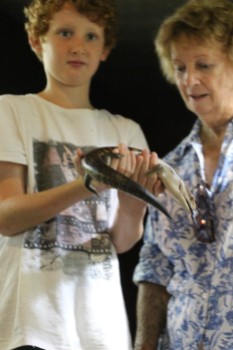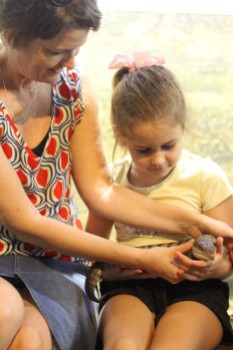
Another fantastic workshop, with a fauna focus was hosted especially for Land for Wildlife members at The Territory Wildlife Park. This workshop focussed on reptiles that are likely to be found in Top End landscapes and particularly properties of the rural Darwin area and how best to manage habitat for their success.
Nearly 30 Land for Wildlife members all boarded the train on another slightly sweaty but beautiful Saturday morning to meet Dion Wedd, curator of the collections at Territory Wildlife Park. In the nocturnal house Dion gave us a background to reptiles in the Top End and how we can look after their habitat, as well as all the participants having an opportunity to see and even handle some of the species themselves, including a Blue- tounged lizard (actually a skink), a Frill-necked lizard, a Tree frog and others.

There are over 300 species of Lizards, snakes, turtles and frogs that can be found in the landscapes of the Top end region and about 1/3 of those in Darwin and rural region. Lizards include numerous small skinks which are common even in suburban gardens and rummage around in leaf litter, Dragons- Frill-necked Lizards (Chlamydosarus kingii), Tree Dragon (Gowidon temporalis) and Gilbert’s dragon (Lophognathus gilberti) gheckos and goannas, there are also Pygopods, which are legless lizards (and yes they look quite like a snake).

Frill-necked lizard (photo by Alice Buckle)

Northern spade-foot toad (by Alice Buckle)

Mains frog (photo by Alice Buckle)
In wetter areas we find amphibians (frogs, toads and toadlets) in great numbers, turtles and water monitors. Many Land for Wildlife properties include inundated areas of Sandsheet, treed swamp or freshwater creeks.
And snakes, yep there are lots of them, over 40 species in the Top End region, many of the more common ones found in the Darwin region. Unfortunately there is a culture of humans in Australia fearing snakes and wanting to kill them, often without much knowledge of their behaviour or how harmful they are. Generally keeping a distance and letting them be is the best action.

We joined Greg Mayo, Wildlife keeper in the monsoon rainforest, who told us a lot of amazing information about snakes, their behaviour and habitat and showed us a live Black-headed python (Aspdithes melancephalus). We were also informed of some snake first aid and who to call if a snake was too near.
Australia has 8 of the Top 10 deadliest snakes in the world, but only (on average) one person dies of a snake bite per year and almost always they were bitten when trying to catch it, handle it or had hurt it. Compared to other statics of how people die in Australia, that is pretty low on the list, we should be a lot more worried about cars, other humans and bad food or alcohol!
After our talks we had time to enjoy the reptile displays in the rainforest and got together at the main station for brunch and everyone got to share stories and tips on land management for reptiles on their own properties.


The biggest threat to reptiles in our region are ‘inappropriate fire regimes’, Cane Toads and possibly at the Top of the list habitat loss (land clearing.) So good land management practice and the efforts of landholders (and our members) is of great importance.
“Inappropriate fire” is fire that is too widespread, too regular or too late in the season, or a combination of these factors. Most reptiles find it hard to get away from fire, they will try and find an underground or wet place or move to an unburnt area. If fire is later in the dry season (and enhanced with extra fuel from grassy weeds) it will often kill most lizard (and some mammal) species in the landscape. You will see birds of prey circling overhead ready to eat the grilled animals. IN addition to this, the leaf litter layer, where many smaller species thrive is taken away with fire.
On most small rural blocks, keeping fire out of the property with fire breaks and diligence is the best strategy.
Cane toads seem to have dented many reptile populations with competition and predation, although these populations have stabilised land managers can keep on top of cane toads by “disposing of them” as quickly and painlessly as possible…
Keep up the great work and a big Thanks to The Territory Wildlife Park staff for all their time and knowledge.


































